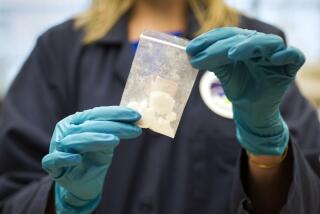Contaminated heparin called a global issue
- Share via
WASHINGTON — A contaminated blood thinner from China suspected in dozens of U.S. deaths has become a worldwide public health problem, with 10 other countries detecting the often-toxic ingredient, federal investigators said Monday.
The compound, which in tests mimics the real blood thinner heparin but which costs less to make, may have been added deliberately somewhere along a production chain that began on farms in China, beyond the reach of U.S. regulators.
Food and Drug Administration officials issued a warning letter Monday that banned future U.S. shipments from the plant in China that supplied the widely used blood thinner until the safety issues are resolved. And officials raised the possible death toll from 62 to 81.
At the same time, the FDA announced a major scientific breakthrough in its attempt to understand how patients got sick from the contaminated heparin.
The developments came on the eve of a congressional hearing expected to show that the FDA lacks the resources to carry out adequate inspection of thousands of foreign facilities now producing a significant share of the medications consumed here.
“Contamination of the heparin supply is a worldwide problem,” said Dr. Janet Woodcock, director of the FDA’s Center for Drug Evaluation and Research. About a dozen Chinese facilities have been identified as being part of the supply chain that handled contaminated heparin.
The widely used blood thinner is given to patients to prevent dangerous clots when they undergo kidney dialysis or heart surgery. The ingredient that contaminated the drug, a chemically modified form of a common nutritional supplement, has been shown in laboratory and animal tests to cause the dangerous reactions that some patients experienced, Woodcock said. These included a sudden drop in blood pressure, leading to shock.
Woodcock explained that the contaminant -- a compound called an over-sulfated chondroitin sulfate -- can trigger chemicals in blood cells that produce serious allergic-type reactions.
These chemicals, called blood mediators, are often spurred into action when a wound is opened, helping to generate new blood vessels around the wound and drawing in antibodies to clean up damaged areas, said Marilyn Halonen, a pharmacology professor at the University of Arizona.
But blood mediators also can cause a drop in blood pressure and other reactions in patients who receive large doses of contaminated heparin.
“If this compound is getting to a lot of cells at once, it’s causing a mediator storm,” Halonen said. The FDA’s Woodcock said the dangerous reactions seen in U.S. patients and some in Germany may be linked to large intravenous doses of contaminated heparin.
“It does appear that the route of administration, the amount and how fast it’s administered may play a role,” she said.
Chinese officials, however, have remained skeptical of the existence of such a link. At a Chinese Embassy news conference Monday, senior public health officials said they doubted the evidence linking the contaminant to serious side effects. Instead, they urged a look at the U.S. facilities of Baxter Healthcare Corp., the Illinois-based company that imported heparin from China and distributed it in the U.S.
The FDA and Baxter have maintained that the source of the problem is in China.
Heparin is produced from a naturally occurring substance found in the lining of pigs’ intestines, and the process involves several layers of middlemen and suppliers. The contaminant could have been added in to make the drug seem more potent, or it could have been introduced accidentally.
On Monday, the FDA cited Baxter’s supplier in China for “significant deviations” from U.S. manufacturing practices. That supplier, Changzhou SPL, is a joint venture company partly owned by Wisconsin-based Scientific Protein Laboratories.
In its warning letter, the FDA said it found problems with the process used by the Chinese plant to remove impurities from heparin, and also with the company’s system for evaluating its suppliers. Changzhou SPL responded with a statement saying many of the concerns the FDA cited had already been corrected. But the agency says it will require more proof before the Changzhou plant is allowed to export to the U.S. again.
In a report to be released today at a House hearing, investigators from the congressional Government Accountability Office found that the agency’s budget for foreign inspections is not up to the task. The FDA has about $11 million for foreign inspections this year, but it would need about $70 million a year to inspect foreign pharmaceutical plants every two years, the rate for U.S. establishments. It would need $16 million a year to inspect the estimated 714 drug-manufacturing facilities in China alone.
--
ricardo.alonso-zaldivar@latimes.com
Jonathan D. Rockoff of the Baltimore Sun contributed to this report.
More to Read
Sign up for Essential California
The most important California stories and recommendations in your inbox every morning.
You may occasionally receive promotional content from the Los Angeles Times.













